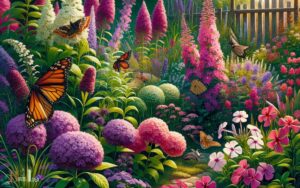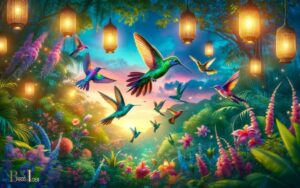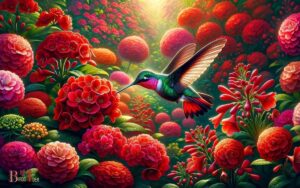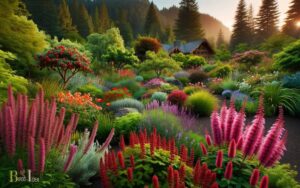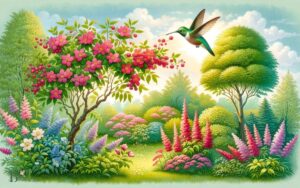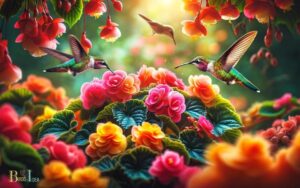Hanging Plants That Attract Hummingbirds: Discover!
Hanging plants with vivid flowers and sweet nectar are excellent for attracting hummingbirds. Favorites include Fuchsia, Lobelia, Petunia, Salvia, Trumpet Vine, Bee Balm, Cuphea, and Coral Honeysuckle.
Hummingbirds are attracted to certain types of hanging plants due to their colorful flowers and nectar content.
These plants can be hung on porches, patios, or gardens to create a hummingbird-friendly habitat.
Some of the most attractive hanging plants for hummingbirds include:
Create a hummingbird haven with hanging plants that provide nectar and color to attract these charming birds.
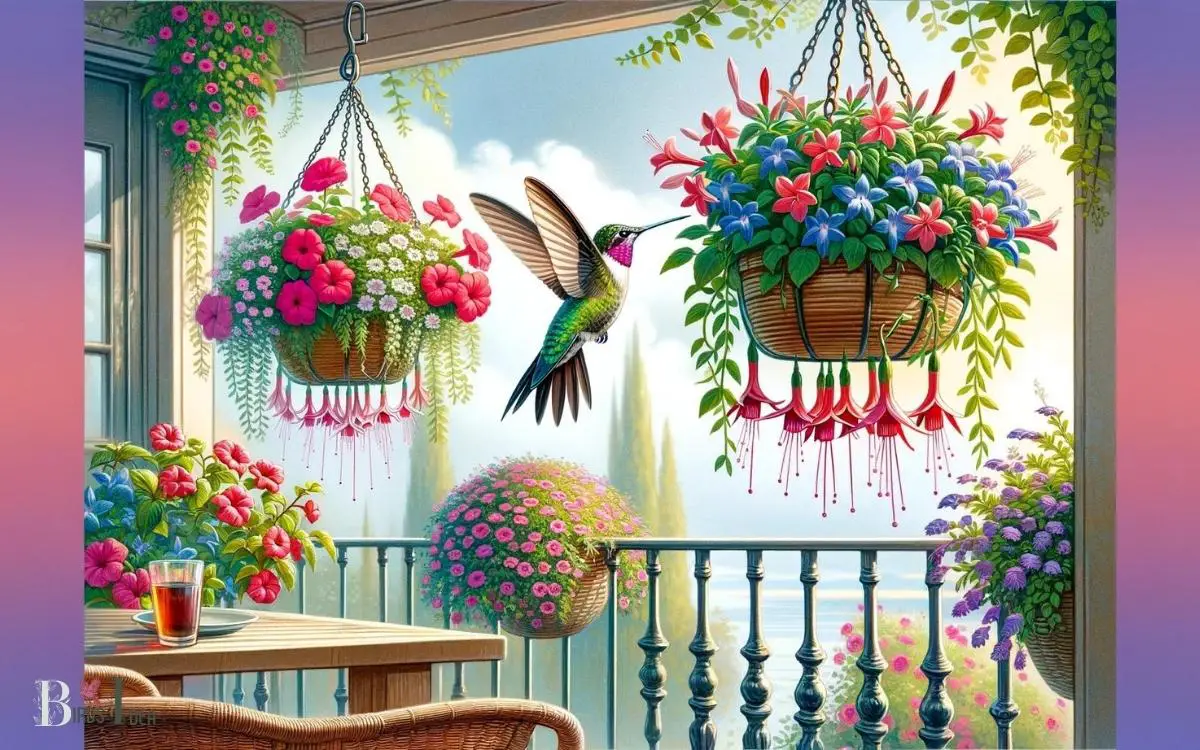
Key Takeaway
Best Hanging Plants for Attracting Hummingbirds
| Plant | Flower Color | Flower Shape | Nectar Rich |
|---|---|---|---|
| Fuchsia | Various | Bell-shaped | Yes |
| Lobelia | Blue, Red | Small, intense | Moderate |
| Petunia | Various | Trumpet-shaped | Moderate |
| Salvia | Various | Tubular | Yes |
| Trumpet Vine | Orange, Red | Trumpet-shaped | Yes |
| Bee Balm | Red, Pink, Purple | Open, tubular | Yes |
| Cuphea | Red, Purple | Tubular | Yes |
| Coral Honeysuckle | Red, Coral | Tubular | Yes |
Fuchsia
Fuchsia’s vibrant, pendulous flowers make it an appealing choice for gardeners seeking to attract hummingbirds.
These delicate, bell-shaped blooms, available in various shades of red, purple, and pink, act as a natural magnet for these tiny, energetic birds.
Fuchsia plants are well-suited for hanging baskets, making them an excellent option for those with limited garden space.
Their nectar-rich flowers provide a vital food source for hummingbirds, while the plants’ trailing habit offers the perfect cover for these birds to perch and rest. Additionally, fuchsias thrive in shaded areas, adding versatility to their appeal.
With their stunning displays and hummingbird-attracting properties, fuchsias make a delightful addition to any garden or outdoor space, providing both beauty and a touch of wildlife magic.
Lobelia
Lobelia is a popular choice for attracting hummingbirds with its vibrant, tubular flowers that the birds love.
Its trailing habit makes it an excellent hanging plant, perfect for adding a pop of color to any garden or patio.
Lobelia for Hummingbirds
Hummingbirds are drawn to the vibrant blooms of Lobelia, making it a popular choice for hanging planters. The tubular flowers of Lobelia produce nectar that hummingbirds find irresistible.
Here’s why Lobelia is a great choice for attracting hummingbirds:
- Colorful Blooms: Lobelia flowers come in various shades of red, pink, purple, and blue, which catch the attention of hummingbirds.
- Long Blooming Period: The continuous blooming of Lobelia provides a consistent nectar source for hummingbirds throughout the growing season.
- Compact Size: With its trailing, compact growth habit, Lobelia is well-suited for hanging baskets, making it convenient for hummingbirds to access the nectar.
Lobelia’s ability to attract hummingbirds while adding a pop of color to hanging planters makes it a delightful addition to any garden.
Lobelia Hanging Plant
The vibrant blooms of the Lobelia hanging plant are a favorite nectar source for hummingbirds.
With their striking shades of red, blue, and purple, Lobelia plants are known for attracting these tiny, iridescent birds to gardens and balconies.
The tubular shape of the flowers makes it easy for hummingbirds to feed on the sweet nectar within.
Here’s a comparison of different types of Lobelia hanging plants:
| Lobelia Variety | Color | Height |
|---|---|---|
| Cardinalis | Red | 24-36″ |
| Siphilitica | Blue | 12-36″ |
| Erinus | Purple | 6-12″ |
These varieties offer a range of colors and sizes, allowing for flexibility in attracting hummingbirds to different spaces.
Planting Lobelia in hanging baskets or containers can create beautiful displays while providing essential nourishment for these delightful birds.
Petunia
Petunias are often prized by gardeners for their vibrant colors and prolific blooming, which can attract hummingbirds when planted in hanging baskets.
When considering petunias for a hanging basket to attract hummingbirds, gardeners should keep in mind the following:
- Color Variety: Petunias come in a wide range of colors, including reds, pinks, purples, and whites. Opting for bright, vivid hues can capture the attention of hummingbirds.
- Maintenance: These plants require regular watering and deadheading to encourage continuous blooming, making them a low-maintenance option for a hanging basket.
- Sunlight: Petunias thrive in full sun, so ensure the hanging basket is placed in an area that receives ample sunlight for optimal growth and blooming.
Salvia
Salvia is known as a hummingbird magnet, making it a popular choice for hanging plants that attract these beautiful creatures.
Gardeners can benefit from growing tips for Salvia, such as the importance of well-draining soil and full sun exposure.
There is a wide variety of Salvia plants to choose from, including different colors and sizes, offering options to suit different garden preferences.
Salvia Hummingbird Magnet
A popular choice for attracting hummingbirds to hanging planters is the Salvia Hummingbird Magnet, known for its vibrant blooms and ability to draw in these delightful birds.
This variety of salvia is an excellent addition to any garden or hanging planter, and here’s why:
- Long Blooming Period: The Salvia Hummingbird Magnet produces beautiful, tubular flowers in shades of red, pink, or purple that can bloom from late spring through fall, providing a consistent food source for hummingbirds.
- Low Maintenance: This salvia variety is relatively low maintenance, requiring well-drained soil, regular watering, and full sun to thrive, making it an ideal choice for hanging planters.
- Attracts Pollinators: Apart from hummingbirds, the Salvia Hummingbird Magnet also attracts butterflies and bees, contributing to a vibrant and lively garden ecosystem.
Growing Tips for Salvia
How can gardeners ensure that their hanging Salvia Hummingbird Magnet thrives and continues to attract hummingbirds?
Salvia, also known as sage, is a low-maintenance plant that is easy to grow and can attract hummingbirds with its vibrant flowers.
To ensure optimal growth, plant Salvia in well-draining soil and provide it with full sunlight. Water the plant regularly, especially during dry spells, but be cautious not to overwater as Salvia prefers slightly dry conditions.
Deadheading, or removing faded flowers, can encourage more blooms and prolong the flowering period.
Additionally, applying a balanced fertilizer in early spring can promote healthy growth. As the Salvia plant grows, it may benefit from occasional pruning to maintain its shape and encourage new growth.
Best Salvia Varieties
When considering the best Salvia varieties for attracting hummingbirds, gardeners can explore a range of options to find the ideal plant for their garden.
Salvia, also known as sage, is a diverse genus with many species and cultivars, but some are particularly attractive to hummingbirds.
Here are some of the best Salvia varieties to consider:
- Salvia guaranitica: This variety, also known as Anise-Scented Sage, produces vibrant blue flowers that are irresistible to hummingbirds.
- Salvia coccinea: With its tubular red flowers, this variety, also known as Scarlet Sage, is a favorite of hummingbirds and adds a pop of color to the garden.
- Salvia elegans: Known as Pineapple Sage, this variety boasts bright red tubular flowers and a delightful pineapple scent, making it a magnet for hummingbirds.
These Salvia varieties not only attract hummingbirds but also add beauty and charm to any garden.
Trumpet Vine
One popular choice for attracting hummingbirds to hanging plants is the Trumpet Vine. This woody, fast-growing vine produces vibrant, trumpet-shaped flowers that are a magnet for hummingbirds.
The Trumpet Vine, also known as Campsis radicans, thrives in full sun and well-drained soil, making it an excellent option for hanging baskets in sunny locations.
Its bright orange, red, or yellow blossoms appear in summer and continue into fall, providing a long-lasting food source for hummingbirds.
When choosing a hanging plant to attract hummingbirds, the Trumpet Vine is a top contender due to its ability to draw these delightful birds with its nectar-rich flowers.
Gardeners seeking to bring the beauty and charm of hummingbirds to their outdoor spaces can consider adding the Trumpet Vine to their hanging plant collection.
Bee Balm
Bee Balm, also known as Monarda, often attracts hummingbirds with its colorful, nectar-rich flowers.
The vibrant blooms of Bee Balm make it a popular choice for gardeners looking to create a hummingbird-friendly environment.
Here are three reasons why Bee Balm is a great addition to any hummingbird garden:
- Colorful Blooms: Bee Balm produces showy flowers in shades of red, pink, purple, and white, which are highly attractive to hummingbirds.
- Abundant Nectar: The nectar-rich flowers of Bee Balm provide a valuable food source for hummingbirds, helping to sustain them throughout the season.
- Long Blooming Period: Bee Balm has a long blooming period, often lasting from early summer through to the fall, providing a consistent food source for visiting hummingbirds.
Cuphea
Cuphea, another attractive option for hummingbird gardens, offers small, tubular flowers that are rich in nectar, continuing the trend of providing abundant food sources for visiting hummingbirds.
These flowers, which come in shades of red, pink, and purple, are perfectly suited to the hummingbird’s long, slender bill.
Cuphea, commonly known as cigar plant or firecracker plant, is a low-maintenance, compact plant that thrives in hanging baskets and containers.
Its ability to attract hummingbirds is due to the copious amounts of nectar it produces, making it a delightful addition to any garden seeking to draw these enchanting birds.
With its vibrant blooms and ability to create a welcoming environment for hummingbirds, Cuphea is a must-have for any hummingbird enthusiast’s garden.
Coral Honeysuckle
Coral honeysuckle, also known as trumpet honeysuckle, is a popular hanging plant that attracts hummingbirds with its vibrant tubular flowers.
This native North American vine is a favorite of gardeners and hummingbird enthusiasts for its ability to entice these beautiful creatures.
Here are a few key points to consider about coral honeysuckle:
- Blooming Period: This plant produces clusters of tubular, coral-red flowers from late spring through early summer, providing a long-lasting food source for hummingbirds.
- Growing Conditions: Coral honeysuckle thrives in full sun to part shade and well-drained soil, making it a versatile and low-maintenance addition to hanging baskets or containers.
- Hummingbird Magnet: The nectar-rich flowers of coral honeysuckle attract hummingbirds, making it a delightful and visually appealing choice for any hummingbird garden.
Conclusion
Hanging plants that attract hummingbirds are a beautiful addition to any garden or outdoor space. They not only add color and vibrancy, but also provide a welcoming environment for these delightful birds.
Whether it’s the cascading blooms of fuchsia, the delicate petals of lobelia, or the vibrant hues of petunia and salvia, there’s a perfect hanging plant for everyone to enjoy the company of hummingbirds.
So, why not add some of these plants to your outdoor space and attract these amazing creatures?

